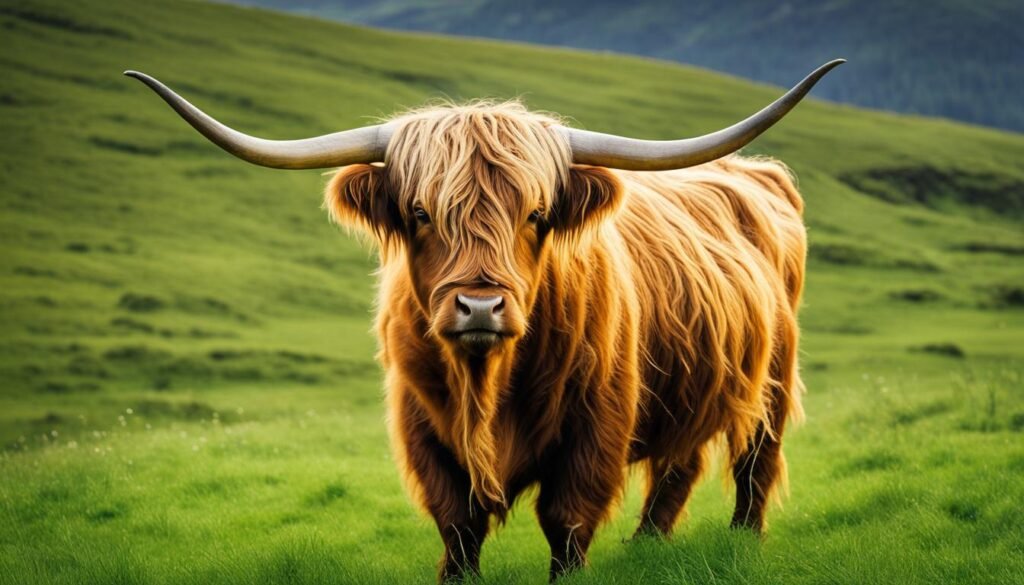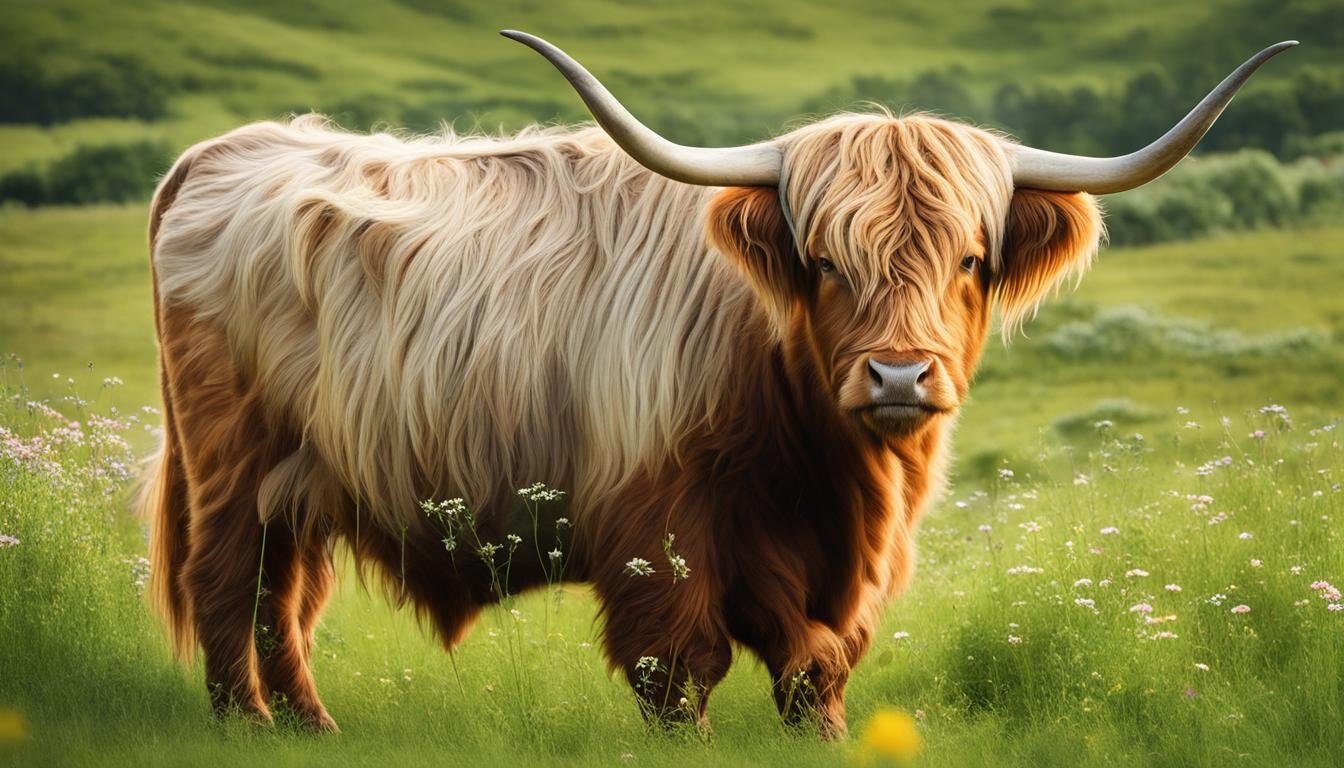Have you ever wondered what a cow with long hair is called? Look no further than the magnificent Highland cow! Known for their luxurious, flowing coats, Highland cows are a unique breed of long-haired cattle. They possess a double coat of long hair that provides them with natural insulation from extreme weather conditions.
Highland cows, also referred to as Highland coos, have become synonymous with Scotland’s picturesque landscapes. Their mane-like hair and peaceful demeanor make them an iconic symbol of the Scottish Highlands.
The Highland cow is the oldest registered cattle breed in the world, with a history dating back centuries. They are renowned for their remarkable senses and ability to navigate rough terrains with ease. Despite their long fringe, known as “dossan,” Highland cows have excellent vision and can adapt to various environments.
Notably, Highland cows come in various colors, including shades of black, brown, yellow, white, grey, and tan. Contrary to popular misconception, they are not exclusively ginger in color. Each Highland cow boasts its unique and stunning coat pattern, adding to their individual charm and appeal.
Their flowing hair sets them apart from other cattle breeds, earning them the title of the long-haired cattle breed. Their majestic appearance, coupled with their hearty nature, makes them a favorite amongst farmers and nature enthusiasts alike.
Stay tuned to discover more about the fascinating attributes, uses, and whereabouts of Highland cows in the upcoming sections!
The Difference Between Highland Cows and Other Breeds
Highland cows, also known as Highland coos or Highland cattle, exhibit several distinct features that set them apart from other cattle breeds. These characteristics contribute to their overall uniqueness and appeal. Let’s explore the key differences between Highland cows and their counterparts:
- Long Lifespan and High Fertility: Highland cows have a longer average lifespan compared to other breeds and can continue breeding past 18 years old. They are known for their fertility and can bear up to 15 calves during their lifetime.
- Collective Name: While a group of cows is generally referred to as a herd, a group of Highland cattle is known as a “fold.” This name originated from the open shelters, also called folds, in which they seek refuge during winter.
- Horn Differences: The most noticeable distinction between male and female Highland cattle lies in their horns. Bulls have wider horns that often grow forwards or slightly downwards, while cows possess longer and finer horns that face upwards. These unique horns are an integral characteristic of the breed.
With their longer lifespan, high fertility, and distinctive horns, Highland cows showcase notable divergences from other cattle breeds. These unique features contribute to their recognition and popularity within the farming community and beyond.
Take a look at this beautiful Highland cow image below:
The Unique Attributes of Highland Cows
Highland cows possess several unique attributes that distinguish them from other cattle breeds. The most notable feature is their long, flowing hair, which gives them a majestic appearance. A double coat characterizes their long hair, consisting of a coarse outer coat that can reach up to 33cm in length and a softer, woollier inner coat. This extraordinary hair serves a vital purpose – it provides natural insulation against extreme weather conditions such as bitter cold, heavy rainfall, and powerful winds. The long hair allows Highland cows to thrive in the harsh climates of the Scottish Highlands and other cold regions.
Despite their impressive mane-like hair, Highland cows have excellent vision and remarkable senses. Their long fringe, also known as the “dossan,” does not obstruct their line of sight. This enables them to navigate rugged terrains and adapt to various landscapes. Their vision, along with their sturdy build and sharp horns, assists them in foraging for food even in challenging environments. For instance, during the day, Highland cows can use their horns to dig through snow and find nourishment beneath it.
“Highland cows have an impressive ability to survive in harsh conditions while maintaining their distinctive appearance. Their long hair provides insulation and protection, allowing them to thrive in cold climates. Their vision, along with their exceptional senses, helps them navigate rugged terrains and find food.”
Highland cows exhibit a wide range of hair colors, contradicting the common belief that they are only ginger in color. Their coats can be found in shades of black, brown, yellow, white, grey, tan, and even white. Each hue adds to their unique beauty and diversity. These various colors further contribute to their recognition and fascination among both locals and tourists.

| Vision | Hair Color |
|---|---|
| Excellent vision allows navigation through rugged terrains | Coats come in various colors including black, brown, yellow, white, grey, and tan |
The Benefits and Uses of Highland Cows
Highland cows offer several benefits and have various uses. They are primarily bred for their meat, which is leaner, with 40% less fat and cholesterol than normal beef. Their ability to convert poor grazing into tender, marbled beef makes them economically valuable for Scotland’s uplands.
While it is possible to milk a Highland cow, they do not produce large quantities of milk compared to dairy cows. Their smaller teats and higher butterfat content make their milk less desirable for consumption.
Additionally, Highland cows are hardy and can withstand harsh winter conditions. They are often kept in open stone shelters called “folds” and are well-adapted to live in cold and wet weather.
When it comes to uses, the primary purpose of Highland cows is for meat production. Their lean and tender beef is sought after for its excellent flavor and lower fat content. Whether it’s a hearty stew or a juicy steak, Highland cow meat is a delicious and healthier alternative to conventional beef.
Although milk production is not their main use, their milk can still be used to make dairy products such as cheese and butter. The higher butterfat content in their milk adds richness and flavor to these products.
Furthermore, Highland cows play an important role in conservation grazing. Due to their ability to thrive in harsh environments and graze on rough grasses, they are often employed to manage and maintain grassland habitats. Their grazing habits help preserve the biodiversity and ecology of the land.
| Benefit | Use |
|---|---|
| Lean and tender meat | Meat production |
| Lower fat and cholesterol | |
| Conservation grazing | |
| Smaller teats and higher butterfat content | Milk and dairy production |
| Adapted to harsh weather |
In summary, the benefits and uses of Highland cows extend beyond their stunning appearance. From their lean and tender meat to their ability to graze in challenging environments, these remarkable animals contribute to the culinary world, conservation efforts, and the sustainability of Scotland’s uplands.
Where to Find Highland Cows
If you’re eager to catch a glimpse of the majestic Highland cows, there are a few key locations where you’re more likely to spot them. The Scottish Highlands, Scottish Islands, and the Isle of Skye are the best places to find these iconic creatures. However, be aware that their whereabouts can be unpredictable as they are frequently moved across fields for grazing.
Scotland offers various popular spots where you can have the chance to encounter Highland cows. Loch Lubnaig, the Isle of Mull, Applecross, Plockton, Loch Ness, and Loch Lomond are just a few examples of picturesque locations where these magnificent creatures can often be found. But keep in mind that you may encounter limited photo opportunities due to restricted parking near the cows.
Don’t worry if you can’t make it to Scotland, though. Highland cows have been exported to other countries as well. Countries such as Australia, Canada, Denmark, Finland, and the United States have welcomed these fascinating creatures into their landscapes, allowing you to spot them outside of Scotland.
